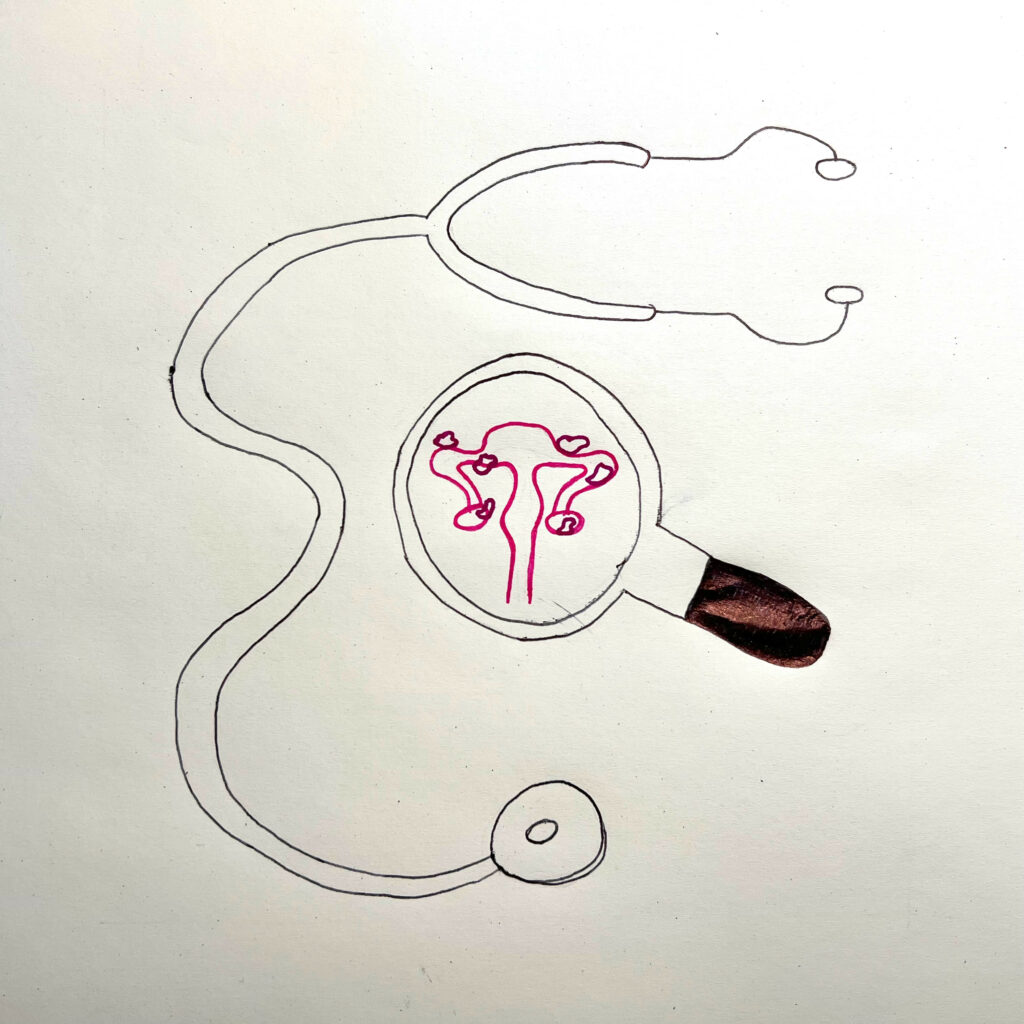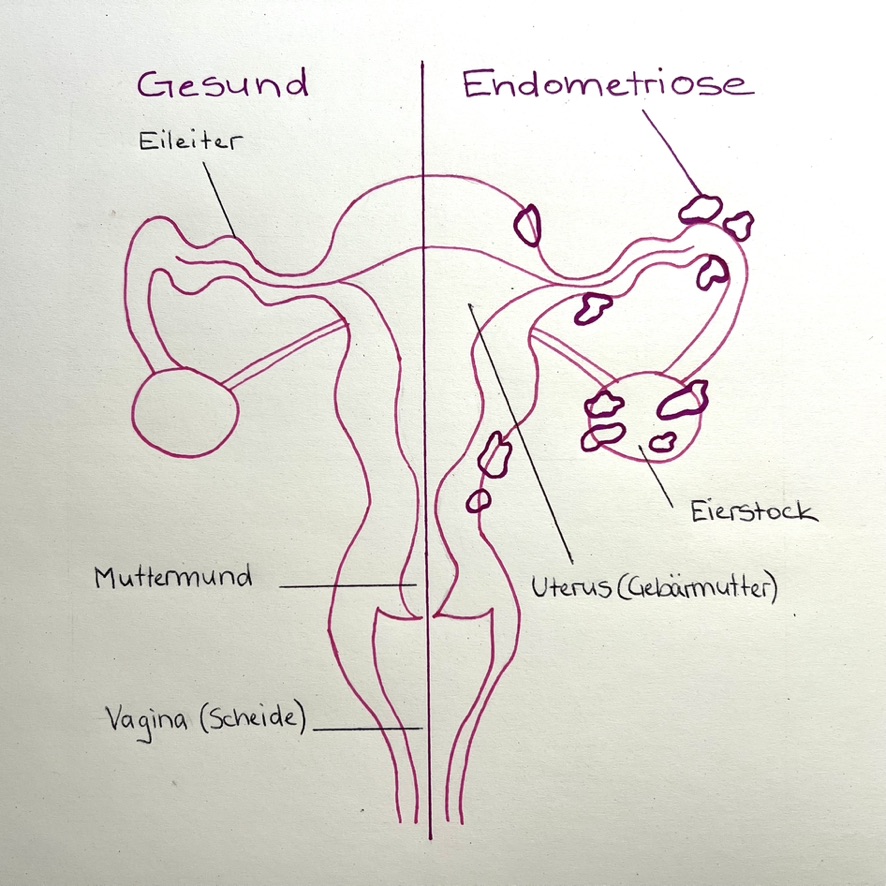In Germany, nearly every tenth person with a uterus is affected by endometriosis – but a lot of people are hearing about the gynecological disease for the first time when they are getting diagnosed. What is endometriosis and how can it be treated?
An Overview
By endometriosis, tissue similar to the lining of the uterus forms outside the uterine cavity.
This leads to development of endometriosis foci as well as inflammation. Proliferations (cysts) on the ovaries, in the abdomen and pelvic cavity, on the intestines or on the abdominal peritoneum may develop. Cysts are encapsulated hollow spaces in tissue filled with tissue fluid, blood and additional sebum or pus. The disease is chronic but benign. Occasionally, endometriosis foci can grow on other tissue and cause permanent damage to organs like the intestine or the fallopian tubes. In exceptional cases, endometriosis tissue can build up outside the abdomen, for example in the lungs.

Particularly characteristic, the disease may lead to establishments of such cellular meshwork throughout the whole body. Due to the different progressions of the disease in affected as well as the complex and strongly varying symptoms, Endometriosis is often called as “Chameleon of Gynecology” in medicine. Endometriosis counts to the most frequent gynecological diseases and can occur in all people with a uterus. In few cases, the tissue was also found in men during a prostate cancer treatment.
The disease is most likely to appear between the ages of 35 and 45. About 8 to 15 percent of all people with a uterus are affected, which is around two million people in Germany. According to the WHO (World Health Organization), around 190 million people have been diagnosed worldwide. Every year, 40,000 new cases are registered in Germany.
Symptoms
As already mentioned, the disease progression can vary greatly. Half of those affected may require permanent therapy, while others with the disease can live without treatment or symptoms.
Symptoms of endometriosis may include chronical pain, intermediate bleeding, nausea and vomiting, cyclical bleeding from bowel and/or bladder and occasionally pain during sexual intercourse and ovulation. Particularly frequent is severe pain during menstruation which can also occur cycle independent though. Endometriosis can lead to pain within the whole body. In many cases, infertility is possible as well: 40 to 50 percent of the affected have limited fertility due to the disease.
From a medical point of view, endometriosis is a systemic disease, which means that the symptoms can affect the immune system as well as the hormone balance. Therefore, it should be threatened by doctors from different specialties on an interdisciplinary basis.
Diagnosis

It can take up to ten years before a final diagnosis is made, as misdiagnoses often occur. For example, endometriosis is commonly confused with an inflammation of the ovaries, psychogenic complaints, or PMS (premenstrual syndrome). Reason for this is the versatility of the disease, the great variance among patients and the different ways in which the body’s organs are affected. Additionally, menstrual complaints are usually talked down and hardly taken seriously. When diagnosing endometriosis, it is therefore important to take a detailed anamnesis interview, as the nature and frequency of symptoms can provide initial clues and can be decisive in the diagnostic procedure. If endometriosis is suspected, there are several approaches, such as taking an anamnesis interview, which is an in-depth conversation of the symptoms and the general condition. Furthermore, palpation of the vagina, rectum or uterine ligaments are carried out. An ultrasound of the peritoneum or vagina can also be insightful. Depending on the symptoms, colonoscopies may be carried out.
The disease can now also be diagnosed by specialists using imaging techniques such as ultrasound or MRI.
Surgical interventions are the most common procedure. During an abdominal endoscopy, tissue samples (biopsy) are taken and then examined. This allows determining the location, severity and growth type of the endometriosis foci and cysts.
Treatment

Various treatment possibilities exist to decrease the symptoms, but they are dependent on the intensity of complaints as well as if there is a desire to have children. Basically, there are three treatment options: Medication, hormones, and surgery. These are supplemented by additional therapeutic approaches. For example, painkillers, hormones, or surgical intervention are recommended to patients who mainly complain about pain and cramps. But if there is a desire to have children, a hormone therapy is not an option, because the hormonal active ingredients inhibit the endogenous hormone production within the ovaries and therefore also suppress ovulation and menstruation. Fundamentally, hormone therapy involves treatment with progestogen and birth control pill, although some pills can make symptoms worse. To relief pain, also drugs from the GnRH analogue group of active ingredients are used, which are synthetic hormonal substances that prevent premature ovulation. Progestogen is a sex hormone which is, next to estrogen, component of the birth control pill. Preparations with progestogen are recommended to treat endometriosis hormonally because they have a pain-relieving effect. But side effects can occur, such as intermenstrual bleeding, reduced libido, and weight gain.
Most birth control pills verifiably reduce pain symptoms from affected. However, side effects such as water retention, a feeling of tightness in the chest, and headaches can also occur. Hormonal drugs from the GnRH analogue group of active ingredients may help as well. Though, there are even more severe side effects possible than with the birth control pill. They often include an estrogen deficiency, as the GnRH analogies greatly reduce the production of female hormones. Similar to the symptoms of the menopause, this can lead to mood swings, sleep disorders, hot flushes and vaginal dryness.
Drug treatment mainly involves the prescription of ibuprofen and other pain-relieving substances. Endometriosis foci and cysts can usually be removed by surgery such as abdominal endoscopy (laparoscopy). However, endometriosis has a high recurrence rate: the endometriosis foci can reappear after surgical removal. In extreme cases, patients even decide to have their uterus removed (hysterectomy) if the symptoms are unbearable, their life is too restricted by the disease, other treatment therapies have been unsuccessful and there is no desire to have children. But this does not guarantee that the endometriosis is cured. If ovaries and fallopian tubes are not removed, the symptoms may persist; if both ovaries are removed, the production of female sex hormones is stopped, and the menopause starts immediately.
Counseling centers and self-help groups
In Germany, 100 medically certified endometriosis facilities exist. A distinction is made between practices, clinics, and centers. Beyond that, they are numerous counseling centers like the “Endometriose-Vereinigung Deutschland e. V.”. This is the largest and oldest association of those who are affected by endometriosis in Germany. The association has over 3,000 members, is independent and active nationwide. It offers free counseling and arranges contact to local and virtual self-help groups.
The “Netzwerk Endometriose”, consisting of two affiliated self-help groups in Dresden and Leipzig, aims to provide comprehensive information for sufferers and support them in difficult life situations. If required, affected people receive information on diagnosis and treatment options. The self-help network offers a sense of security and relief due to the community and compassion among each other.
Awareness campaign

Despite its high prevalence and partly serious consequences for pain patients, endometriosis is hardly recognized in society. A lot of people are hearing about the disease for the first time when they are getting diagnosed. However, there are campaigns that are targeting to raise awareness of the disease.
Annually in March, the largest campaign worldwide takes place: the “Endometriosis Awareness Month”. The aim is to raise attention of the disease and give those affected a voice. In 1993, the movement was brought to life by the “Endometriosis Association” in Milwaukee, USA. Symbol of the endometriosis campaign is a yellow ribbon, which, similar to the pink ribbon against breast cancer, makes a statement of awareness against the disease. In 2021, the “Endometriose Vereinigung Deutschland e.V.” developed the information campaign “JUNG UND ENDO” (Youth and Endo), where they provide teaching and workshop concepts and materials for youth work on the topics of menstruation, menstrual complaints, and endometriosis. Moreover, there are brochures, posters and digital media. Free materials on menstruation and endometriosis are available for lessons. The teaching and workshop concept is primarily aimed at pupils aged 12 to 15 to educate them about menstruation and diseases like endometriosis at an early age.
State of research

So far, the causes of endometriosis are not clear. Currently, there are no scientifically confirmed theories on this; generally, there is a sex-related data gap in medicine. As a result, up to now, there is no treatment which can causally cure the disease.
But there are some theses. In 2023, researchers of the “Science Translational Medicine”-Journal argue that fusobacteria could be the cause of endometriosis. Then, the use of antibiotics would be an option for treatment. Fusobacteria are natural part of the oral and intestinal flora. Though, if the immune system is weakened, this can lead to formation of abscesses in mouth or to abdominal infections. This can also lead to inflammations in the genital area. Scientists of the university Nagoya (Japan) examined 155 women (79 people affected by endometriosis, 76 people not affected by endometriosis) to see whether the bacteria could also be found in the uterus. According to the study, the specific bacterium was found in 64 percent of the affected patients, while less than ten percent of the healthy participants were found to have bacteria in uterus. But if the fusobacteria are cause, consequence or side-effect of endometriosis is unclear.
Thus, this is not a final result and further research is necessary. With investments of several million Australian Dollars, Australia is far ahead in the course if this, closely followed by France. Both countries pursue a national action plan to explore endometriosis. In Germany, there is no such plan up to this point. In September 2023, requests by the Left Party and the CDU/CSU for a nationwide education and research strategy were rejected in the German House of Representatives (Bundestag). In the last two decades, only 500,000 euros have been provided by the German government. In October last year, the Federal Ministry of Education and Research decided to provide five million euros for research into endometriosis for the first time from 2023.
Considering the prevalence of endometriosis and the current research state, the five million euros provided are relatively small. There is still known too little about endometriosis, even though so many people suffer from this disease.
Text: Marie-Florence Vierling
Translation: Renja-Arlene Dietze
